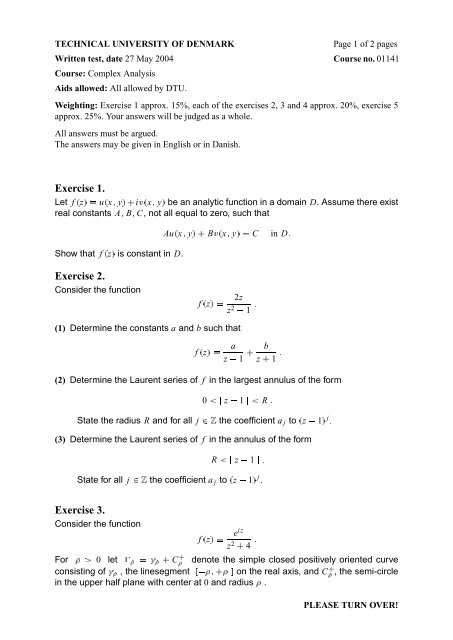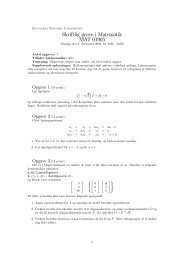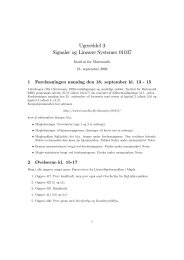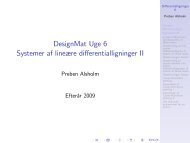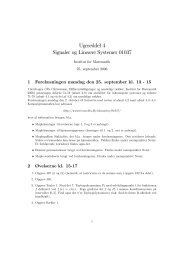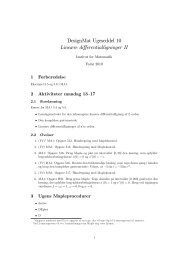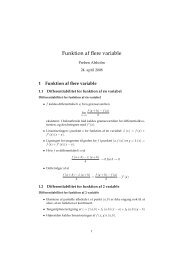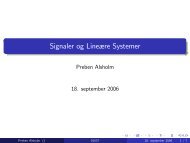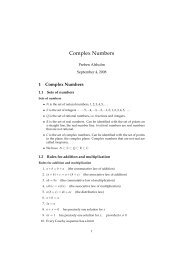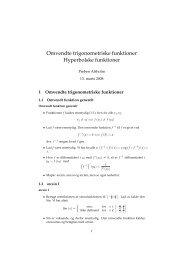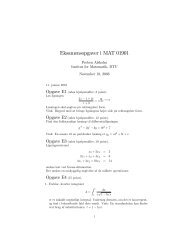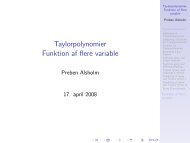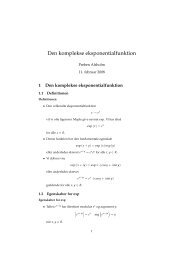Exercise 1. Exercise 2. Exercise 3.
Exercise 1. Exercise 2. Exercise 3.
Exercise 1. Exercise 2. Exercise 3.
Create successful ePaper yourself
Turn your PDF publications into a flip-book with our unique Google optimized e-Paper software.
TECHNICAL UNIVERSITY OF DENMARK<br />
Page 1 of 2 pages<br />
Written test, date 27 May 2004 Course no. 01141<br />
Course: Complex Analysis<br />
Aids allowed: All allowed by DTU.<br />
Weighting: <strong>Exercise</strong> 1 approx. 15%, each of the exercises 2, 3 and 4 approx. 20%, exercise 5<br />
approx. 25%. Your answers will be judged as a whole.<br />
All answers must be argued.<br />
The answers may be given in English or in Danish.<br />
<strong>Exercise</strong> <strong>1.</strong><br />
Let f.z/ D u.x; y/ C iv.x; y/ be an analytic function in a domain D. Assume there exist<br />
real constants A; B; C, not all equal to zero, such that<br />
Au.x; y/ C Bv.x; y/ D C in D:<br />
Show that f.z/ is constant in D.<br />
<strong>Exercise</strong> <strong>2.</strong><br />
Consider the function<br />
f.z/ D<br />
:<br />
2z<br />
z 2 1<br />
(1) Determine the constants a and b such that<br />
f.z/ D<br />
a<br />
z 1 C<br />
:<br />
b<br />
z C 1<br />
(2) Determine the Laurent series of f in the largest annulus of the form<br />
0 0 let 0 D C CC denote the simple closed positively oriented curve<br />
consisting of , the linesegment T ; C U on the real axis, and CC , the semi-circle<br />
in the upper half plane with center at 0 and radius .<br />
PLEASE TURN OVER!
–2–<br />
(1) Determine for> 2 the value of<br />
Z<br />
0<br />
(2) Show that Z<br />
Z C1<br />
(3) State the values of the improper integrals<br />
e<br />
p.v.<br />
1 ix<br />
C C <br />
f.z/ dz:<br />
f.z/ dz ! 0 as ! C1:<br />
x 2 C 4 dx and p.v. Z C1<br />
cos x<br />
1 : x 2 C 4 dx<br />
<strong>Exercise</strong> 4.<br />
Consider the function<br />
h.z/ D f.z/ g.z/<br />
where f.z/ D e z 1 and g.z/ D cos z:<br />
(1) Determine the zeros of f and g and their order. Determine the isolated singularities<br />
of h and state their type.<br />
(2) State the radius of convergence of the Maclaurin series of h, and find the coefficients<br />
a 0 ; a 1 ; a 2 ; a 3 of the series.<br />
<strong>Exercise</strong> 5.<br />
Consider the Möbius transformation<br />
f.z/ D 1 z C 1 2 i 2<br />
:<br />
Let C 1 denote the circle jz ij D 1 and C 2 the circle jz 1j D 1 . Let D 1 denote the<br />
open disc bounded by C 1 and D 2 the open disc bounded by C 2 . Set A D D 1 [ D 2 .<br />
(1) Sketch the circles C 1 and C 2 . Show that<br />
f.C 1 / D R [ f1g and f.C 2 / D iR [ f1g:<br />
(2) Determine the images f.D 1 / and f.D 2 / of the discs and the image f.A/ of their<br />
union.<br />
(3) Let<br />
L 0 V C n f0g ! C<br />
denote the branch of the logarithm defined as<br />
L 0 .z/ D ln jzj C i arg 0 .z/<br />
where 0


